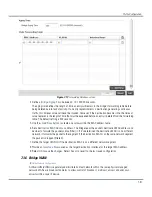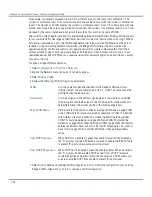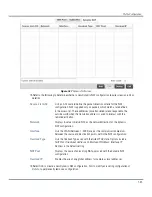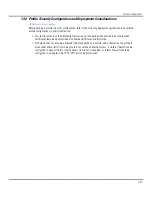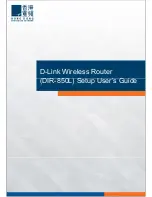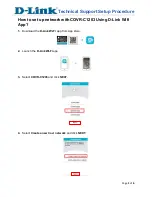
Profile Configuration
7-39
7. Select
OK
to save the changes made within the Certificate Revocation screen. Select
Reset
to revert to
the last saved configuration.
7.4.3 Setting the Profile’s NAT Configuration
Profile Security Configuration
Network Address Translation
(NAT) is a technique to modify network address information within IP packet
headers in transit across a traffic routing device. This enables mapping one IP address to another to protect
network address credentials. With typical deployments, NAT is used as an IP masquerading technique to
hide private IP addresses behind a single, public facing, IP address.
NAT is a process of modifying network address information in IP packet headers while in transit across a
traffic routing device for the purpose of remapping one IP address to another. In most deployments NAT is
used in conjunction with IP masquerading which hides RFC1918 private IP addresses behind a single public
IP address.
NAT can provide a profile outbound Internet access to wired and wireless hosts connected to an AP-6511.
Many-to-one NAT is the most common NAT technique for outbound Internet access. Many-to-one NAT
allows an Access Point to translate one or more internal private IP addresses to a single, public facing, IP
address assigned to a 10/100/1000 Ethernet port or 3G card.
To define a NAT configuration that can be applied to a profile:
1. Select the Configuration tab from the Web UI
2. Select
Profiles
from the Configuration tab.
3. Either select
Add
if creating a new profile or
Edit
if modifying the configuration on an existing profile.
4. Select
Security
.
5. Select
NAT
.
Summary of Contents for AP-6511
Page 1: ...Motorola Solutions AP 6511 Access Point System Reference Guide ...
Page 2: ...Motorola Solutions AP 6511 Access Point System Reference Guide 1 2 ...
Page 24: ...Motorola Solutions AP 6511 Access Point System Reference Guide 2 12 ...
Page 318: ...Motorola Solutions AP 6511 Access Point System Reference Guide 10 16 ...
Page 409: ...Statistics 13 49 Figure 13 31 Access Point Firewall Packet Flow screen ...
Page 433: ......







